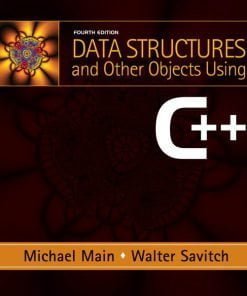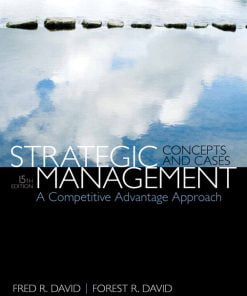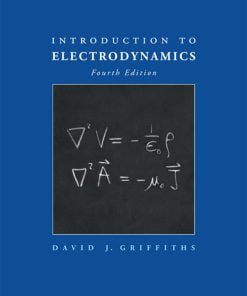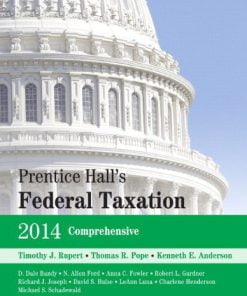Physical Chemistry 2nd Edition Ball Solutions Manual
$35.00 Original price was: $35.00.$26.50Current price is: $26.50.
Physical Chemistry 2nd Edition Ball Solutions Manual
This is completed downloadable of Physical Chemistry 2nd Edition Ball Solutions Manual
Product Details:
- ISBN-10 : 1133958435
- ISBN-13 : 978-1133958437
- Author: Ball
With its easy-to-read approach and focus on core topics, PHYSICAL CHEMISTRY, 2e provides a concise, yet thorough examination of calculus-based physical chemistry. The Second Edition, designed as a learning tool for students who want to learn physical chemistry in a functional and relevant way, follows a traditional organization and now features an increased focus on thermochemistry, as well as new problems, new two-column examples, and a dynamic new four-color design. Written by a dedicated chemical educator and researcher, the text also includes a review of calculus applications as applied to physical chemistry.
Table of Content:
- Ch 1: Gases and the Zeroth Law of Thermodynamics
- Introduction
- 1.1: Synopsis
- 1.2: System, Surroundings, and State
- 1.3: The Zeroth Law of Thermodynamics
- 1.4: Equations of State
- 1.5: Partial Derivatives and Gas Laws
- 1.6: Nonideal Gases
- 1.7: More on Derivatives
- 1.8: A Few Partial Derivatives Defined
- 1.9: Thermodynamics at the Molecular Level
- 1.10: Summary
- Key Equations
- Exercises for Chapter 1
- Ch 2: The First Law of Thermodynamics
- Introduction
- 2.1: Synopsis
- 2.2: Work and Heat
- 2.3: Internal Energy and the First Law of Thermodynamics
- 2.4: State Functions
- 2.5: Enthalpy
- 2.6: Changes in State Functions
- 2.7: Joule-Thomson Coefficients
- 2.8: More on Heat Capacities
- 2.9: Phase Changes
- 2.10: Chemical Changes
- 2.11: Changing Temperatures
- 2.12: Biochemical Reactions
- 2.13: Summary
- Key Equations
- Exercises for Chapter 2
- Ch 3: The Second and Third Laws of Thermodynamics
- Introduction
- 3.1: Synopsis
- 3.2: Limits of the First Law
- 3.3: The Carnot Cycle and Efficiency
- 3.4: Entropy and the Second Law of Thermodynamics
- 3.5: More on Entropy
- 3.6: Order and the Third Law of Thermodynamics
- 3.7: Entropies of Chemical Reactions
- 3.8: Summary
- Key Equations
- Exercises for Chapter 3
- Ch 4: Gibbs Energy and Chemical Potential
- Introduction
- 4.1: Synopsis
- 4.2: Spontaneity Conditions
- 4.3: The Gibbs Energy and the Helmholtz Energy
- 4.4: Natural Variable Equations and Partial Derivatives
- 4.5: The Maxwell Relationships
- 4.6: Using Maxwell Relationships
- 4.7: Focus on ∆G
- 4.8: The Chemical Potential and Other Partial Molar Quantities
- 4.9: Fugacity
- 4.10: Summary
- Key Equations
- Exercises for Chapter 4
- Ch 5: Introduction to Chemical Equilibrium
- Introduction
- 5.1: Synopsis
- 5.2: Equilibrium
- 5.3: Chemical Equilibrium
- 5.4: Solutions and Condensed Phases
- 5.5: Changes in Equilibrium Constants
- 5.6: Amino Acid Equilibria
- 5.7: Summary
- Key Equations
- Exercises for Chapter 5
- Ch 6: Equilibria in Single-Component Systems
- Introduction
- 6.1: Synopsis
- 6.2: A Single-Component System
- 6.3: Phase Transitions
- 6.4: The Clapeyron Equation
- 6.5: Gas-Phase Effects
- 6.6: Phase Diagrams and the Phase Rule
- 6.7: Natural Variables and Chemical Potential
- 6.8: Summary
- Key Equations
- Exercises for Chapter 6
- Ch 7: Equilibria in Multiple-Component Systems
- Introduction
- 7.1: Synopsis
- 7.2: The Gibbs Phase Rule
- 7.3: Two Components: Liquid/Liquid Systems
- 7.4: Nonideal Two-Component Liquid Solutions
- 7.5: Liquid/Gas Systems and Henry’s Law
- 7.6: Liquid/Solid Solutions
- 7.7: Solid/Solid Solutions
- 7.8: Colligative Properties
- 7.9: Summary
- Key Equations
- Exercises for Chapter 7
- Ch 8: Electrochemistry and Ionic Solutions
- Introduction
- 8.1: Synopsis
- 8.2: Charges
- 8.3: Energy and Work
- 8.4: Standard Potentials
- 8.5: Nonstandard Potentials and Equilibrium Constants
- 8.6: Ions in Solution
- 8.7: Debye-Hückel Theory of Ionic Solutions
- 8.8: Ionic Transport and Conductance
- 8.9: Summary
- Key Equations
- Exercises for Chapter 8
- Ch 9: Pre-Quantum Mechanics
- Introduction
- 9.1: Synopsis
- 9.2: Laws of Motion
- 9.3: Unexplainable Phenomena
- 9.4: Atomic Spectra
- 9.5: Atomic Structure
- 9.6: The Photoelectric Effect
- 9.7: The Nature of Light
- 9.8: Quantum Theory
- 9.9: Bohr’s Theory of the Hydrogen Atom
- 9.10: The de Broglie Equation
- 9.11: The End of Classical Mechanics
- Key Equations
- Exercises for Chapter 9
- Ch 10: Introduction to Quantum Mechanics
- Introduction
- 10.1 Synopsis
- 10.2 The Wavefunction
- 10.3: Observables and Operators
- 10.4: The Uncertainty Principle
- 10.5: The Born Interpretation of the Wavefunction; Probabilities
- 10.6: Normalization
- 10.7: The Schrödinger Equation
- 10.8: An Analytic Solution: The Particle-in-a-Box
- 10.9: Average Values and Other Properties
- 10.10: Tunneling
- 10.11: The Three-Dimensional Particle-in-a-Box
- 10.12: Degeneracy
- 10.13: Orthogonality
- 10.14: The Time-Dependent Schrödinger Equation
- 10.15: Summary of Postulates
- Key Equations
- Exercises for Chapter 10
- Ch 11: Quantum Mechanics: Model Systems and the Hydrogen Atom
- Introduction
- 11.1: Synopsis
- 11.2: The Classical Harmonic Oscillator
- 11.3: The Quantum-Mechanical Harmonic Oscillator
- 11.4: The Harmonic Oscillator Wavefunctions
- 11.5: The Reduced Mass
- 11.6: Two-Dimensional Rotations
- 11.7: Three-Dimensional Rotations
- 11.8: Other Observables in Rotating Systems
- 11.9: The Hydrogen Atom: A Central Force Problem
- 11.10: The Hydrogen Atom: The Quantum-Mechanical Solution
- 11.11: The Hydrogen Atom Wavefunctions
- 11.12: Summary
- Key Equations
- Exercises for Chapter 11
- Ch 12: Atoms and Molecules
- Introduction
- 12.1: Synopsis
- 12.2: Spin
- 12.3: The Helium Atom
- 12.4: Spin Orbitals and the Pauli Principle
- 12.5: Other Atoms and the Aufbau Principle
- 12.6: Perturbation Theory
- 12.7: Variation Theory
- 12.8: Linear Variation Theory
- 12.9: Comparison of Variation and Perturbation Theories
- 12.10: Simple Molecules and the Born-Oppenheimer Approximation
- 12.11: Introduction to LCAO-MO Theory
- 12.12: Properties of Molecular Orbitals
- 12.13: Molecular Orbitals of Other Diatomic Molecules
- 12.14: Summary
- Key Equations
- Exercises for Chapter 12
- Ch 13: Introduction to Symmetry in Quantum Mechanics
- Introduction
- 13.1: Synopsis
- 13.2: Symmetry Operations and Point Groups
- 13.3: The Mathematical Basis of Groups
- 13.4: Molecules and Symmetry
- 13.5: Character Tables
- 13.6: Wavefunctions and Symmetry
- 13.7: The Great Orthogonality Theorem
- 13.8: Using Symmetry in Integrals
- 13.9: Symmetry-Adapted Linear Combinations
- 13.10: Valence Bond Theory
- 13.11: Hybrid Orbitals
- 13.12: Summary
- Key Equations
- Exercises for Chapter 13
- Ch 14: Rotational and Vibrational Spectroscopy
- Introduction
- 14.1: Synopsis
- 14.2: Selection Rules
- 14.3: The Electromagnetic Spectrum
- 14.4: Rotations in Molecules
- 14.5: Selection Rules for Rotational Spectroscopy
- 14.6: Rotational Spectroscopy
- 14.7: Centrifugal Distortions
- 14.8: Vibrations in Molecules
- 14.9: The Normal Modes of Vibration
- 14.10: Quantum-Mechanical Treatment of Vibrations
- 14.11: Selection Rules for Vibrational Spectroscopy
- 14.12: Vibrational Spectroscopy of Diatomic and Linear Molecules
- 14.13: Symmetry Considerations for Vibrations
- 14.14: Vibrational Spectroscopy of Nonlinear Molecules
- 14.15: Nonallowed and Nonfundamental Vibrational Transitions
- 14.16: Group Frequency Regions
- 14.17: Rotational-Vibrational Spectroscopy
- 14.18: Raman Spectroscopy
- 14.19: Summary
- Key Equations
- Exercises for Chapter 14
- Ch 15: Introduction to Electronic Spectroscopy and Structure
- Introduction
- 15.1: Synopsis
- 15.2: Selection Rules
- 15.3: The Hydrogen Atom
- 15.4: Angular Momenta: Orbital and Spin
- 15.5: Multiple Electrons: Term Symbols and Russell-Saunders Coupling
- 15.6: Electronic Spectra of Diatomic Molecules
- 15.7: Vibrational Structure and the Franck-Condon Principle
- 15.8: Electronic Spectra of Polyatomic Molecules
- 15.9: Electronic Spectra of π Electron Systems: Hückel Approximations
- 15.10: Benzene and Aromaticity
- 15.11: Fluorescence and Phosphorescence
- 15.12: Lasers
- 15.13: Summary
- Key Equations
- Exercises for Chapter 15
- Ch 16: Introduction to Magnetic Spectroscopy
- Introduction
- 16.1: Synopsis
- 16.2: Magnetic Fields, Magnetic Dipoles, and Electric Charges
- 16.3: Zeeman Spectroscopy
- 16.4: Electron Spin Resonance
- 16.5: Nuclear Magnetic Resonance
- 16.6: Summary
- Key Equations
- Exercises for Chapter 16
- Ch 17: Statistical Thermodynamics: Introduction
- Introduction
- 17.1: Synopsis
- 17.2: Some Statistics Necessities
- 17.3: The Ensemble
- 17.4: The Most Probable Distribution: Maxwell-Boltzmann Distribution
- 17.5: Thermodynamic Properties from Statistical Thermodynamics
- 17.6: The Partition Function: Monatomic Gases
- 17.7: State Functions in Terms of Partition Functions
- 17.8: Summary
- Key Equations
- Exercises for Chapter 17
- Ch 18: More Statistical Thermodynamics
- Introduction
- 18.1: Synopsis
- 18.2: Separating q: Nuclear and Electronic Partition Functions
- 18.3: Molecules: Electronic Partition Functions
- 18.4: Molecules: Vibrations
- 18.5: Diatomic Molecules: Rotations
- 18.6: Polyatomic Molecules: Rotations
- 18.7: The Partition Function of a System
- 18.8: Thermodynamic Properties of Molecules from Q
- 18.9: Equilibria
- 18.10: Crystals
- 18.11: Summary
- Key Equations
- Exercises for Chapter 18
- Ch 19: The Kinetic Theory of Gases
- Introduction
- 19.1: Synopsis
- 19.2: Postulates and Pressure
- 19.3: Definitions and Distributions of Velocities of Gas Particles
- 19.4: Collisions of Gas Particles
- 19.5: Effusion and Diffusion
- 19.6: Summary
- Key Equations
- Exercises for Chapter 19
- Ch 20: Kinetics
- Introduction
- 20.1: Synopsis
- 20.2: Rates and Rate Laws
- 20.3: Characteristics of Specific Initial Rate Laws
- 20.4: Equilibrium for a Simple Reaction
- 20.5: Parallel and Consecutive Reactions
- 20.6: Temperature Dependence
- 20.7: Mechanisms and Elementary Processes
- 20.8: The Steady-State Approximation
- 20.9: Chain and Oscillating Reactions
- 20.10: Transition-State Theory
- 20.11: Summary
- Key Equations
- Exercises for Chapter 20
- Ch 21: The Solid State: Crystals
- Introduction
- 21.1: Synopsis
- 21.2: Types of Solids
- 21.3: Crystals and Unit Cells
- 21.4: Densities
- 21.5: Determination of Crystal Structures
- 21.6: Miller Indices
- 21.7: Rationalizing Unit Cells
- 21.8: Lattice Energies of Ionic Crystals
- 21.9: Crystal Defects and Semiconductors
- 21.10: Summary
- Key Equations
- Exercises for Chapter 21
- Ch 22: Surfaces
- Introduction
- 22.1: Synopsis
- 22.2: Liquids: Surface Tension
- 22.3: Interface Effects
- 22.4: Surface Films
- 22.5: Solid Surfaces
- 22.6: Coverage and Catalysis
- 22.7: Summary
- Key Equations
- Exercises for Chapter 22
- Appendixes
- Appendix 1: Useful Integrals
- Appendix 2: Thermodynamic Properties of Various Substances
- Appendix 3: Character Tables
- Appendix 4: Infrared Correlation Tables
- Appendix 5: Nuclear Properties
- Answers to Selected Exercises
- Index
People Also Search:
atkins physical chemistry 2nd edition
physical chemistry 2nd edition year
physical chemistry mcquarrie 2nd edition
Related products
Solution Manual
Solution Manual for Data Structures and Other Objects Using C++, 4/E Michael Main, Walter Savitch
Solution Manual
Solution Manual
International Accounting Doupnik 4th Edition Solutions Manual
Solution Manual
Solution Manual for Introduction to Electrodynamics, 4/E 4th
Solution Manual
Solution Manual for Absolute C++, 5/E 5th Edition Walter Savitch
Solution Manual
Prentice Hall’s Federal Taxation 2014 Comprehensive Rupert 27th Edition Solutions Manual
Solution Manual
Solution Manual for Introduction to Robotics Mechanics and Control 3rd Edition by Craig












